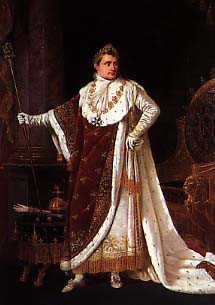The Légion d'honneur was instituted by Bonaparte on 29 Floréal, An X, (19 May, 1802) as a reward for civil and military services and virtues which had “contributed to the defence and prosperity of the country”. Borrowing its name from Roman antiquity, it took as its motto the words “Honour and Homeland”.
There are three degrees of honour:
– Légionnaire – called Chevalier (Knight from 1808 on)
– Officier (Officer)
– Commandant (changed to Commandeur during the Restauration).
In addition to this there are two dignities:
– Grand-officier (great officer)
– Grand-aigle (Great Eagle) or Grand-croix (Great Cross).
At the time of its creation, France was divided into sixteen territorial divisions, known as cohorts, made up of legionnaires from the different regions. This division ceased in 1809.
In 1804, the Great Chancery of the order of the Légion d'Honneur was installed in a Neo-classical palace built at the end of the 18th century by the architect Rousseau for the Prince of Salm-Kyrbourg. Created just after the First World War, the National Museum of the Légion d'Honneur and the order of knights was inaugurated in 1925. It is today the only history museum in the world to offer a panorama of the national honours of every country on the planet.
The second room to the right of the entrance hall retraces the history of the order of the Légion d'Honneur. It starts with the the Directoire period and the honorific weapons awarded to the bravest warriors, some of which were invented by Bonaparte (e.g., The Cent Sabres or the Hundred Sabres of the Italian Army, 1797).
The custom of rewarding bravery with honorific weapons was regularised by the First Consul with the institution of a decree (of 25 December, 1799) concerning the award of arms of honour: the sabres, rifles, muskets, carbines, drumsticks, grenades, trumpets and axes awarded at the time show that nearly 2,000 servicemen were holders of these rewards. The law creating the Légion d'Honneur conferred on them the position of ex-officio Légionnaire, and with this title, they became the first members of the new institution. The first Légion d'honneur award ceremonies were pictured in the preparatory painting by Debret representing the distribution ceremony at the Church of the Invalides, 15 July, 1804, and in the diorama by Lelièvre representing the distribution at the Boulogne camp, 16 August, the following year.
A few personal mementos of Napoleon I are exhibited nearby: the Croix de chevalier (knight's cross) worn by him at the Boulogne camp, a sword by Biennais and a pair of pistols offered to the Tsar in 1807, a cuirasse (breast plate), and the Légion d'Honneur cross which he wore on Saint Helena, etc.
Napoleon's Collier (or necklace) de la Légion d'Honneur is one of the museum's key pieces. Made by Biennais in gold and enamel, it was worn during the coronation and it appears in the representations of the Emperor in imperial costume (as in the painting here by Robert Lefèvre, on show in the museum).
Other paintings there recount Napoleon's life: “Bonaparte First Consul” by Gros, “The Emperor” by Steuben, “Napoleon on the Evening after Chapaubert” by Charlet, “Napoleon on his Deathbed” by Horace Vernet.
The museum offers a complete panorama of the orders created under the Empire: the Légion d'Honneur, of course, with its development over the period 1804 to 1815; the order of the Couronne de fer (the Iron Crown), founded by Napoleon as the King of Italy in 1805; the order of Réunion, created in 1811 in order to replace the orders that the annexation of the Empire abolished; the order of the Trois Toisons d'Or (Triple Golden Fleece), created in 1809, and the orders created by the Emperor's brothers in their respective kingdoms.
The history of the Légion d'Honneur schools (created in 1805) is illlustrated by a painting by J.B. Isabey representing Madame Campan, the director of this famous institution where notably Caroline Bonaparte and Hortense de Beauharnais were students. Badges and uniforms complete this part of the exhibition.
The Second Empire is shown through various paintings and objects bearing witness to Napoleon III's strong committment to maintaining the prestige of the Légion d'Honneur. Original examples of the other military decorations created are also exhibited: notably the military medal created by the Prince-President Louis-Napoleon in 1852 and the commemorative medals for St Helena, Italy, China, Mexico.


